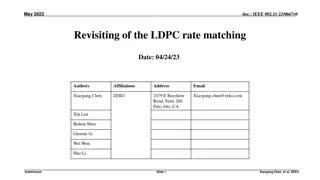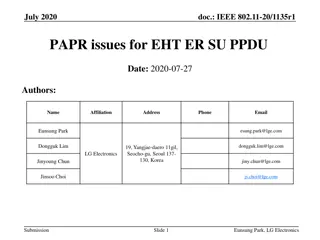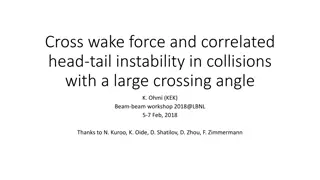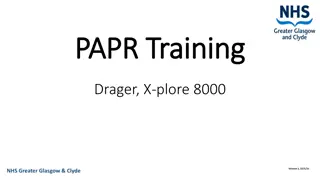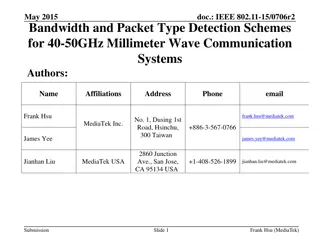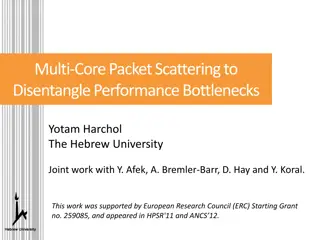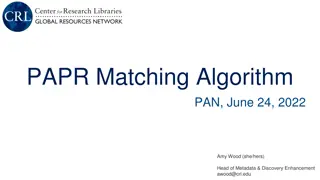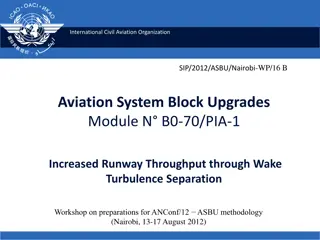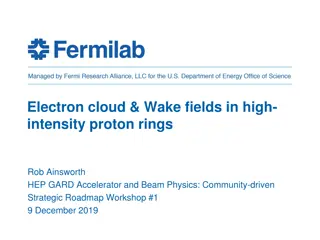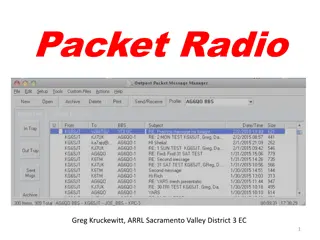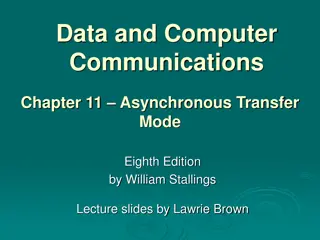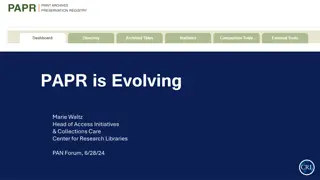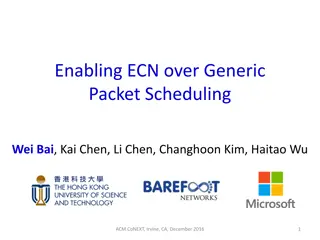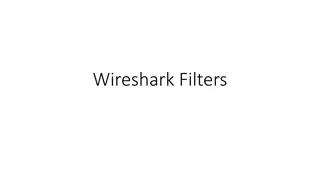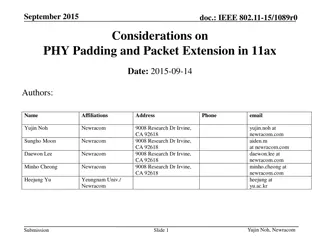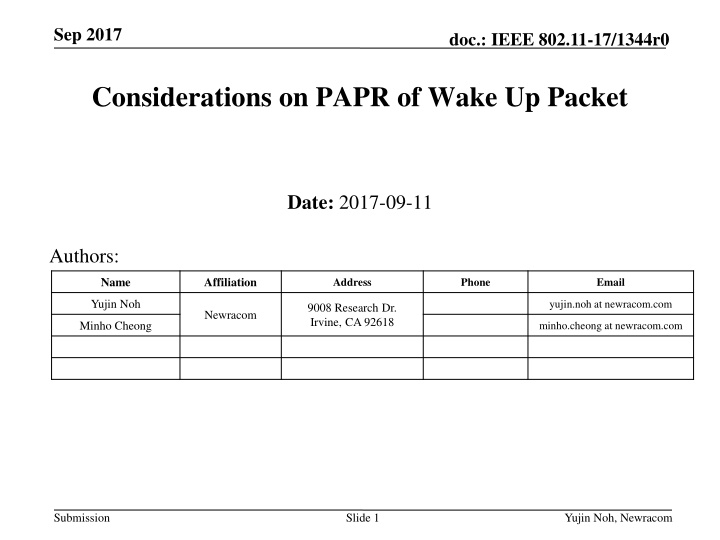
Optimizing PAPR for Wake-Up Packet in IEEE 802.11-17/1344r0
Explore considerations and design requirements for Peak-to-Average Power Ratio (PAPR) in wake-up packets, focusing on PAPR reduction to enhance transmission efficiency and minimize implementation costs of power amplifiers. The document discusses sequence options for OOK waveform generation, PAPR optimization for various packet parts, and the importance of PAPR in OFDM signals. Discover how to maximize dynamic range and minimize PAPR across different packet parts for efficient communication in IEEE 802.11 networks.
Uploaded on | 0 Views
Download Presentation

Please find below an Image/Link to download the presentation.
The content on the website is provided AS IS for your information and personal use only. It may not be sold, licensed, or shared on other websites without obtaining consent from the author. If you encounter any issues during the download, it is possible that the publisher has removed the file from their server.
You are allowed to download the files provided on this website for personal or commercial use, subject to the condition that they are used lawfully. All files are the property of their respective owners.
The content on the website is provided AS IS for your information and personal use only. It may not be sold, licensed, or shared on other websites without obtaining consent from the author.
E N D
Presentation Transcript
Sep 2017 doc.: IEEE 802.11-17/1344r0 Considerations on PAPR of Wake Up Packet Date: 2017-09-11 Authors: Name Affiliation Address Phone Email Yujin Noh yujin.noh at newracom.com 9008 Research Dr. Irvine, CA 92618 Newracom Minho Cheong minho.cheong at newracom.com Submission Slide 1 Yujin Noh, Newracom
Sep 2017 doc.: IEEE 802.11-17/1344r0 Background (1/2) Four options on 13-subcarrier sequence to generate 4us OOK waveform for payload part of wake-up packet were suggested [1] Option 1 : [1,1,1,-1,-1,-1,0,-1,1,-1,-1,1,-1] Option 2 : [1,-1,1,-1,-1,1,0,-1,-1,1,1,1,1] * (1+j)/sqrt(2) Option 3 : [1,-1,1,1,1,1,0,1,-1,-1,1,1,-1] Option 4 : [-1,-1,-1,1,1,-1,0,-1,-1,-1,1,-1,1] Option 5 : none of the above Op1/Op2/Op3/Op4/Op5/A : 8/10/2/1/17/3 Given outcomes from discussion and SP, it seems to be early to determine the sequence for OOK signal. Submission Slide 2 Yujin Noh, Newracom
Sep 2017 doc.: IEEE 802.11-17/1344r0 Background (2/2) Considering that OOK waveform can be generated reusing 802.11 OFDM transmitter [2], PAPR of wake- up packet needs to be carefully taken into account. Since subcarriers are added with IFFT operation, OFDM signal is well-known to have possibly high PAPR. PAPR reduction is important in reducing implementation cost of Tx Power Amplifier and Rx receiver dynamic range related function blocks. Submission Slide 3 Yujin Noh, Newracom
Sep 2017 doc.: IEEE 802.11-17/1344r0 General Design Requirements for PAPR (1/2) In order to maximally utilize the dynamic range of TX PA, worst PAPR across the entire PPDU should be minimized. L-STF and L-LTF has been designed to have lower PAPR. PAPR of L-SIG appears to be a bottleneck eventually. L-SIG has not been optimized to have low PAPR because RATE field and LENGTH field are used for RX to calculate the length of PPDU. According to [1], PAPR of payload part of wake-up packet seems to easily design to have lower PAPR than that of L-SIG. Therefore, PAPR of L-SIG should be optimized. PAPR metric in Appendix Submission Slide 4 Yujin Noh, Newracom
Sep 2017 doc.: IEEE 802.11-17/1344r0 General Design Requirement for PAPR (2/2) In order to have reasonable PAPR of A OFDM symbol, just relying on implementation-dependent sequence may not be recommended. PAPR of preamble part is out of scope in this document. PAPR of payload part is recommended to have an equivalent or smaller PAPR compared to PAPR of L-SIG. Some well-known sequences are shown later for its acceptable PAPR and simplicity to generate. Submission Slide 5 Yujin Noh, Newracom
Sep 2017 doc.: IEEE 802.11-17/1344r0 L-SIG PAPR optimization At an glance, it seems to be difficult to optimize PAPR of L-SIG. Not much bit fields which we can use for PAPR optimization Out-of-the-box idea on L-SIG for PAPR optimization Contents which we can actually use in L-SIG RATE field, LENGTH field, etc. Multiple pairs of RATE and LENGTH field could indicate the same PPDU length. So, we should use this kind of flexibility in order to reduce the PAPR further With PPDU length as 120 us, (RATE, LENGTH) in L-SIG can indicate (0, 71), (4, 293) or (5, 446) Extra edge tones at both side of L-SIG Four extra edge tones (-28, -27, 27 and 28) could be used to reduce L-SIG PAPR Slide 6 Submission Yujin Noh, Newracom
Sep 2017 doc.: IEEE 802.11-17/1344r0 Contents in L-SIG 4 NSYM us 20 us A preamble part of WUP payload part of WUP L-LTF L-SIG L-STF + + 16 8 6 LENGTH = N SYM N DBPS For the 3rd party STAs, Given RATE and LENGTH field in L-SIG, the 3rd party STAs calculate the PPDU length of the wake-up packet for protection. For wake-up radio, Since it can not decode L-SIG correctly, contents in L-SIG are not meaningful. Any combination of (RATE, LEGNTH) does not any impact on the detection/decoding the narrow part of wake-up packet. Submission Slide 7 Yujin Noh, Newracom
Sep 2017 doc.: IEEE 802.11-17/1344r0 How to use extra tones on edge side for L-SIG PAPR optimization Extra tones are mapped to both edge of L-SIG in the frequency domain and not jointly encoded with L- SIG contents. For an HE PPDU, the 4 subcarriers added to the L-SIG are transmitted for channel estimation for HE-SIG-A and HE-SIG-Bs. The number of data subcarriers in HE-SIG-A and HE-SIG-B is increased by 4 in each 20MHz sub-channel. Since legacy devices do not expect or process the extra edge tones, they shouldn t interfere with L-SIG reception The extra tones can be filled with a predetermined sequence that is determined by the contents of the L-SIG to have low PAPR Submission Slide 8 Yujin Noh, Newracom
Sep 2017 doc.: IEEE 802.11-17/1344r0 Optimized L-SIG for PAPR Reduction In [3], estimated payload size of WUR beacon frame could be between 244 us and 316 us. More details in Appendix. E.g.) Given PPDU length of WUR beacon with 276 us, L- SIG can provide lower PAPR (3.85dB) PPDU Length [us] 276 284 L-Length [Byte] 572 1560 PAPR [dB] 3.8527 3.5937 Rate R Extra Tones 3 6 0 0 0 1 -1 -1 0 1 1 1 Submission Slide 9 Yujin Noh, Newracom
Sep 2017 doc.: IEEE 802.11-17/1344r0 Observation on length of Wake-up packet The wake-up packet should be designed for a limited set of usages, and each function requires fixed amount of control information. E.g.) WUR beacon frame is targeted to 1) maintain synchronization and 2) keep stable connection with AP. E.g.) Original purpose of wake-up packet is to focus on waking up the main radio. It is likely to have a specific PPDU length in accordance with its usage. For example, two or three types of PPDU are defined with different rates and its own purpose. E.g) WUR beacon with low rate may have the length of LBEACON us. E.g) WUP to wake up the main radio with low/high rate may have the length of LLOW / LHIGH us Submission Slide 10 Yujin Noh, Newracom
Sep 2017 doc.: IEEE 802.11-17/1344r0 A PAPR Optimization 4 NSYM us 20 us A preamble part of WUP payload part of WUP L-SIG L-LTF L-STF For A OFDM symbol, SFD reads R.3.1.A: A 20 MHz non-HT preamble is prepended in any WUR PPDU, including L-STF, L-LTF and L-SIG fields. A 20 MHz OFDM symbol, with tone spacing 312.5 kHz and BPSK, and of duration 4 us, is present immediately after the L-SIG field and right before the narrow band portion of any WUR PPDU. In [4], A OFDM symbol could be any other BPSK modulated 20MHz OFDM symbol. A sequence by implementation dependent could result in high PAPR for wake-up packet. In order to reduce PAPR of wake-up packet, PAPR of A should not be higher than worst PAPR across the entire PPDU (PAPR of L-SIG). Submission Slide 11 Yujin Noh, Newracom
Sep 2017 doc.: IEEE 802.11-17/1344r0 Payload PAPR Optimization (1/4) 4 NSYM us 20 us A preamble part of WUP payload part of WUP L-LTF L-SIG L-STF The 13 subcarrier sequence to generate 4us OOK waveform for payload part of wake-up packet has not decided whether to have DC tone at the center. SFD says R.3.3.A: When a single band is used for transmission of wake-up packet, the OOK waveform of wake-up packet is generated by using contiguous 13 subcarriers with the subcarrier spacing of 312.5 kHz The center subcarrier is TBD Firstly, I did computer search for the sequences with minimum PAPR in both cases. Case 1 : DC tone inserted / Case 2: DC tone not inserted Then, some well-known sequences with acceptable PAPR are shown as an alternative. Submission Slide 12 Yujin Noh, Newracom
Sep 2017 doc.: IEEE 802.11-17/1344r0 Payload PAPR Optimization (2/4) The sequences which require minor modification (nulling the value at the center) are chosen to be used for two cases in common as examples. Its range of PAPR is around 2-3dB. It seems to be overdesigned compared to PAPRs of other portion of the entire PPDU Case 1 Case 2 PAPR 2.062682 -1 2.062582 -1 2.062582 -1 -1 -1 2.062582 -1 -1 -1 2.062582 2.062582 2.062582 2.062582 2.193824 2.193824 2.193824 -1 -1 -1 -1 -1 2.193824 -1 -1 -1 -1 -1 sequence 1 -1 1 -1 1 1 1 1 PAPR sequence 1 -1 1 -1 -1 -1 1 1 1 1 -1 1 -1 -1 1 -1 -1 0 -1 -1 -1 0 -1 -1 -1 0 1 -1 0 1 -1 0 -1 0 -1 0 1 0 1 0 -1 0 -1 0 1 -1 -1 0 1 -1 -1 1 2.690943 -1 1 2.534147 -1 1 2.534147 -1 -1 -1 1 2.690943 -1 -1 -1 1 -1 2.690943 1 -1 2.534147 1 -1 -1 -1 2.534147 1 -1 -1 -1 2.690943 1 -1 -1 1 3.189696 1 -1 -1 1 3.301042 1 1 -1 3.301042 -1 -1 -1 -1 -1 1 1 -1 3.189696 -1 -1 -1 -1 -1 1 1 1 -1 1 -1 1 1 1 -1 -1 1 -1 -1 1 -1 -1 -1 -1 -1 -1 -1 1 -1 1 -1 1 1 1 1 -1 -1 -1 -1 1 1 1 -1 1 -1 -1 -1 -1 -1 -1 -1 -1 -1 -1 -1 -1 -1 1 1 -1 1 1 -1 1 1 1 1 1 1 1 1 1 1 1 1 1 1 1 1 1 1 1 1 -1 1 -1 1 1 1 1 1 -1 -1 -1 1 -1 -1 -1 1 1 -1 1 1 -1 1 1 1 1 1 -1 -1 1 -1 -1 1 1 1 1 1 1 1 -1 1 -1 1 1 1 1 1 -1 -1 -1 1 -1 -1 -1 -1 -1 1 1 -1 1 1 -1 1 1 1 -1 1 1 1 -1 -1 -1 1 -1 1 -1 1 -1 1 1 1 1 -1 1 1 1 1 1 1 1 1 1 1 -1 1 -1 1 1 1 -1 1 1 1 1 1 1 -1 1 1 1 Submission Slide 13 Yujin Noh, Newracom
Sep 2017 doc.: IEEE 802.11-17/1344r0 Payload PAPR Optimization (3/4) ZC sequences are defined as samples of a complex exponential function as below Length of the sequence Root index between 1 to (NZC -1) ( ( ) 2 for NZCinteger even exp / , j u k N k = ZC / ) 1 ZC ) N + exp ( j u k k N u , ZC for NZCinteger odd ZC Well-known sequence as CAZAC (Constant Amplitude and Zero AutoCorrelation) sequence in 3GPP LTE. Properties of CAZAC sequence in time domain provide good performance for synchronization and cell search. Still provide comparable PAPR of payload part in frequency domain compared with PAPR of L-SIG Submission Slide 14 Yujin Noh, Newracom
Sep 2017 doc.: IEEE 802.11-17/1344r0 Payload PAPR Optimization (4/4) E.g.1) use one sequence for two cases (even regardless of assigned RU position) ( ) 0 Case 2 + 0 E.g.1) -6 k 6 exp ( / ) 1 , / 2 , 0 k 0 / 2 j u k k N N k k N ZC ZC ZC Case 1 = Case 1 u 6 3.646 10 3.722 12 2.467 7 3.806 3 3.898 1 4.377 12 4.594 8 5.130 5 5.155 10 4.820 2 5.477 11 5.638 11 4.858 9 5.859 4 5.917 Case 2 u 1 2.383 ( ) PAPR PAPR / ) 1 + exp ( , / 2 / 2 j u k k N N k N ZC ZC ZC where NZC =13 (odd/prime number) 1 u NZC -1 6 3.911 7 4.057 4 4.233 9 4.269 2 4.762 u = 6 provides comparable PAPR for payload part E.g.2) use cyclic shifted sequence in accordance with assigned RU position. ( 0 3 4.828 ) + 0 exp ( / ) 1 , / 2 , 0 k 0 / 2 j u k k N N k k N ZC ZC ZC Case 1 8 5.701 5 5.942 = ( ) a 1 j / ) 1 + + exp ( , u k k N k a N Case 2 ZC ZC where RU is assigned at [a, a+1, , a+NZC-1] NZC =13 (odd/prime number) 1 u NZC -1 u providing comparable PAPR may be changed depending on the RU location Submission Slide 15 Yujin Noh, Newracom
Sep 2017 doc.: IEEE 802.11-17/1344r0 Overall PAPR over entire Wake-up packet L-STF : 2.2394 dB L-LTF : 3.1658 dB L-SIG with predetermined extra tones Extra tones could be +1, -1, +j, -j, 0 Given PPDU length, R is also selected 1 or 0 depending on Rate and Length field. When there is no combination (Rate, Length, R) fit for PPDU length, overhead (4 or 8 bytes) could be considered. A with PAPR equivalent or less than PAPR of L-SIG Payload part ZC sequence : u = 6 : 3.636 dB (DC inserted) and 3.911 dB (DC not inserted) where 6 k 6 from e.g. 1 Submission Slide 16 Yujin Noh, Newracom
Sep 2017 doc.: IEEE 802.11-17/1344r0 Summary This document has observed options to improve PAPR of each OFDM symbol for wake-up packet. Submission Slide 17 Yujin Noh, Newracom
Sep 2017 doc.: IEEE 802.11-17/1344r0 Reference [1] 11-17/0964r4 Signal Bandwidth and Sequence for OOK Signal Generation [2] 11-17/0084r0 High Level PHY design [3] 11-17/0343r3 WUR Beacon [4] 11-17/0647r4 WUR Legacy Preamble Design Submission Slide 18 Yujin Noh, Newracom
Sep 2017 doc.: IEEE 802.11-17/1344r0 APPENDIX Submission Slide 19 Yujin Noh, Newracom
Sep 2017 doc.: IEEE 802.11-17/1344r0 PAPR metric 99.9% PAPR Oversample rate: 8 0.8 us GI considered as part of the OFDM symbol. Submission Slide 20 Yujin Noh, Newracom
Sep 2017 doc.: IEEE 802.11-17/1344r0 Overhead of WUR Beacon [3] Assume 250 kbps Payload (this is just an example) MAC Header: Packet Type: 4 bits AP ID: 24 bits Frame Body: TSF: 24 bits Other fields: TBD Elements in the Current Beacon: Not applicable FCS: 8 bits Without TSF, the length is 144 us. With TSF, the length is 240 us. 264 + 4 (where bits for TBD and preamble part of wake-up packet Submission Slide 21 Yujin Noh, Newracom
Sep 2017 doc.: IEEE 802.11-17/1344r0 Examples for 4 extra tones PPDU Length [us] 244 244 248 248 252 256 256 260 260 268 276 276 284 288 292 300 300 300 308 308 308 312 316 L-Length [Byte] PAPR [dB] Extra Tones Rate R 4 1 5 7 7 7 5 3 4 5 3 3 6 7 5 0 6 7 0 4 1 6 5 0 1 0 0 1 0 1 0 1 0 0 1 0 1 0 0 1 1 0 0 1 1 0 659 248 1016 1527 1556 1584 1053 536 708 1105 572 564 1560 1779 1220 205 1664 1884 212 849 317 1742 1316 3.8640 3.8808 3.7471 3.9580 3.9167 3.7691 3.8162 3.9143 3.9316 3.9718 3.8527 3.8076 3.5937 3.7894 3.5766 3.9182 3.8944 3.8784 3.9102 3.6020 3.5129 3.8675 3.8175 -1 -1 0 0 -1 -1 0 1 1 -1 0 0 1 -1 1 -1 0 0 -1 1 0 -1 -1 1 -1 -1 0 -1 0 1 0 0 -1 -1 1 -1 0 0 1 -1 1 -1 1 0 1 1 1 -1 0 -1 -1 1 1 -1 0 -1 0 1 1 -1 -1 0 1 -1 0 -1 0 -1 -1 -1 -1 0 1 1 0 1 0 0 -1 1 -1 1 -1 -1 -1 1 1 1 0 0 1 1 Extra tones on top of the predetermined contents in L-SIG provide lower PAPR ( < 4dB) Submission Slide 22 Yujin Noh, Newracom

